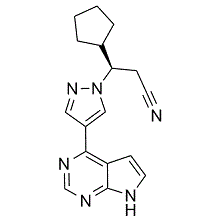| DC7318 |
TG101348(Fedratinib)
|
TG-101348 (SAR302503) is a selective inhibitor of JAK2 with IC50 of 3 nM, 35- and 334-fold more selective for JAK2 versus JAK1 and JAK3, TG-101348 also inhibit BRD4 with IC50 of 340 nM. |
| DC7317 |
TG101209
|
TG101209 is a selective JAK2 inhibitor with IC50 of 6 nM, less potent to Flt3 and RET with IC50 of 25 nM and 17 nM, ~30-fold selective for JAK2 than JAK3, sensitive to JAK2V617F and MPLW515L/K mutations; TG101209 inhibit BRD4 activity with IC50 of 130 nM. |
| DC8309 |
Ruxolitinib Phosphate
|
Ruxolitinib Phosphate is a potent and selective Janus kinase (JAK1, IC50 = 5.9 nM and JAK2, IC50 = 5.7 nM) inhibitor. |
| DC4230 |
Ruxolitinib (INCB018424)
|
Ruxolitinib is a potent ATP mimetic that inhibits both JAK1 and JAK2 with IC50 values of 2.7 and 4.5 nM, respectively and is relatively less selective for JAK3 (IC50 = 322 nM). |
| DC3107 |
Momelotinib (CYT387,CYT-387)
|
CYT387 is an ATP-competitive inhibitor of JAK1 and JAK2 with IC50 of 11 nM and 18 nM, respectively. |
| DC4175 |
BMS-911543
|
BMS-911543 is a potent and selective inhibitor of JAK2 with IC50 of 1.1 nM, approximately 350-, 75- and 65-fold selective to JAK1, JAK3 and TYK2, respectively. |






















